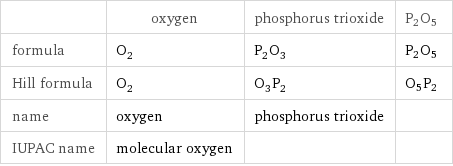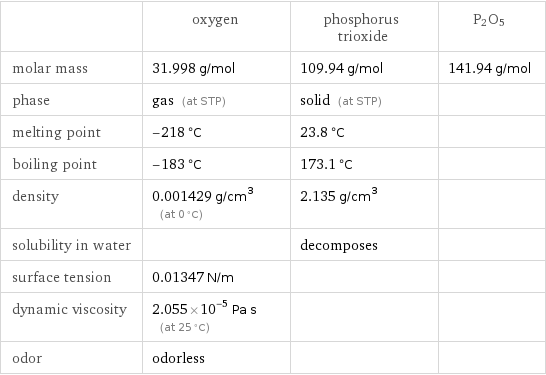Input interpretation

O_2 (oxygen) + P_2O_3 (phosphorus trioxide) ⟶ P2O5
Balanced equation

Balance the chemical equation algebraically: O_2 + P_2O_3 ⟶ P2O5 Add stoichiometric coefficients, c_i, to the reactants and products: c_1 O_2 + c_2 P_2O_3 ⟶ c_3 P2O5 Set the number of atoms in the reactants equal to the number of atoms in the products for O and P: O: | 2 c_1 + 3 c_2 = 5 c_3 P: | 2 c_2 = 2 c_3 Since the coefficients are relative quantities and underdetermined, choose a coefficient to set arbitrarily. To keep the coefficients small, the arbitrary value is ordinarily one. For instance, set c_1 = 1 and solve the system of equations for the remaining coefficients: c_1 = 1 c_2 = 1 c_3 = 1 Substitute the coefficients into the chemical reaction to obtain the balanced equation: Answer: | | O_2 + P_2O_3 ⟶ P2O5
Structures

+ ⟶ P2O5
Names

oxygen + phosphorus trioxide ⟶ P2O5
Equilibrium constant
![Construct the equilibrium constant, K, expression for: O_2 + P_2O_3 ⟶ P2O5 Plan: • Balance the chemical equation. • Determine the stoichiometric numbers. • Assemble the activity expression for each chemical species. • Use the activity expressions to build the equilibrium constant expression. Write the balanced chemical equation: O_2 + P_2O_3 ⟶ P2O5 Assign stoichiometric numbers, ν_i, using the stoichiometric coefficients, c_i, from the balanced chemical equation in the following manner: ν_i = -c_i for reactants and ν_i = c_i for products: chemical species | c_i | ν_i O_2 | 1 | -1 P_2O_3 | 1 | -1 P2O5 | 1 | 1 Assemble the activity expressions accounting for the state of matter and ν_i: chemical species | c_i | ν_i | activity expression O_2 | 1 | -1 | ([O2])^(-1) P_2O_3 | 1 | -1 | ([P2O3])^(-1) P2O5 | 1 | 1 | [P2O5] The equilibrium constant symbol in the concentration basis is: K_c Mulitply the activity expressions to arrive at the K_c expression: Answer: | | K_c = ([O2])^(-1) ([P2O3])^(-1) [P2O5] = ([P2O5])/([O2] [P2O3])](../image_source/afcea3ad3f1014280ac2e67027d9b737.png)
Construct the equilibrium constant, K, expression for: O_2 + P_2O_3 ⟶ P2O5 Plan: • Balance the chemical equation. • Determine the stoichiometric numbers. • Assemble the activity expression for each chemical species. • Use the activity expressions to build the equilibrium constant expression. Write the balanced chemical equation: O_2 + P_2O_3 ⟶ P2O5 Assign stoichiometric numbers, ν_i, using the stoichiometric coefficients, c_i, from the balanced chemical equation in the following manner: ν_i = -c_i for reactants and ν_i = c_i for products: chemical species | c_i | ν_i O_2 | 1 | -1 P_2O_3 | 1 | -1 P2O5 | 1 | 1 Assemble the activity expressions accounting for the state of matter and ν_i: chemical species | c_i | ν_i | activity expression O_2 | 1 | -1 | ([O2])^(-1) P_2O_3 | 1 | -1 | ([P2O3])^(-1) P2O5 | 1 | 1 | [P2O5] The equilibrium constant symbol in the concentration basis is: K_c Mulitply the activity expressions to arrive at the K_c expression: Answer: | | K_c = ([O2])^(-1) ([P2O3])^(-1) [P2O5] = ([P2O5])/([O2] [P2O3])
Rate of reaction
![Construct the rate of reaction expression for: O_2 + P_2O_3 ⟶ P2O5 Plan: • Balance the chemical equation. • Determine the stoichiometric numbers. • Assemble the rate term for each chemical species. • Write the rate of reaction expression. Write the balanced chemical equation: O_2 + P_2O_3 ⟶ P2O5 Assign stoichiometric numbers, ν_i, using the stoichiometric coefficients, c_i, from the balanced chemical equation in the following manner: ν_i = -c_i for reactants and ν_i = c_i for products: chemical species | c_i | ν_i O_2 | 1 | -1 P_2O_3 | 1 | -1 P2O5 | 1 | 1 The rate term for each chemical species, B_i, is 1/ν_i(Δ[B_i])/(Δt) where [B_i] is the amount concentration and t is time: chemical species | c_i | ν_i | rate term O_2 | 1 | -1 | -(Δ[O2])/(Δt) P_2O_3 | 1 | -1 | -(Δ[P2O3])/(Δt) P2O5 | 1 | 1 | (Δ[P2O5])/(Δt) (for infinitesimal rate of change, replace Δ with d) Set the rate terms equal to each other to arrive at the rate expression: Answer: | | rate = -(Δ[O2])/(Δt) = -(Δ[P2O3])/(Δt) = (Δ[P2O5])/(Δt) (assuming constant volume and no accumulation of intermediates or side products)](../image_source/501583e87880f5e87b22228cf828976e.png)
Construct the rate of reaction expression for: O_2 + P_2O_3 ⟶ P2O5 Plan: • Balance the chemical equation. • Determine the stoichiometric numbers. • Assemble the rate term for each chemical species. • Write the rate of reaction expression. Write the balanced chemical equation: O_2 + P_2O_3 ⟶ P2O5 Assign stoichiometric numbers, ν_i, using the stoichiometric coefficients, c_i, from the balanced chemical equation in the following manner: ν_i = -c_i for reactants and ν_i = c_i for products: chemical species | c_i | ν_i O_2 | 1 | -1 P_2O_3 | 1 | -1 P2O5 | 1 | 1 The rate term for each chemical species, B_i, is 1/ν_i(Δ[B_i])/(Δt) where [B_i] is the amount concentration and t is time: chemical species | c_i | ν_i | rate term O_2 | 1 | -1 | -(Δ[O2])/(Δt) P_2O_3 | 1 | -1 | -(Δ[P2O3])/(Δt) P2O5 | 1 | 1 | (Δ[P2O5])/(Δt) (for infinitesimal rate of change, replace Δ with d) Set the rate terms equal to each other to arrive at the rate expression: Answer: | | rate = -(Δ[O2])/(Δt) = -(Δ[P2O3])/(Δt) = (Δ[P2O5])/(Δt) (assuming constant volume and no accumulation of intermediates or side products)
Chemical names and formulas

| oxygen | phosphorus trioxide | P2O5 formula | O_2 | P_2O_3 | P2O5 Hill formula | O_2 | O_3P_2 | O5P2 name | oxygen | phosphorus trioxide | IUPAC name | molecular oxygen | |
Substance properties

| oxygen | phosphorus trioxide | P2O5 molar mass | 31.998 g/mol | 109.94 g/mol | 141.94 g/mol phase | gas (at STP) | solid (at STP) | melting point | -218 °C | 23.8 °C | boiling point | -183 °C | 173.1 °C | density | 0.001429 g/cm^3 (at 0 °C) | 2.135 g/cm^3 | solubility in water | | decomposes | surface tension | 0.01347 N/m | | dynamic viscosity | 2.055×10^-5 Pa s (at 25 °C) | | odor | odorless | |
Units
